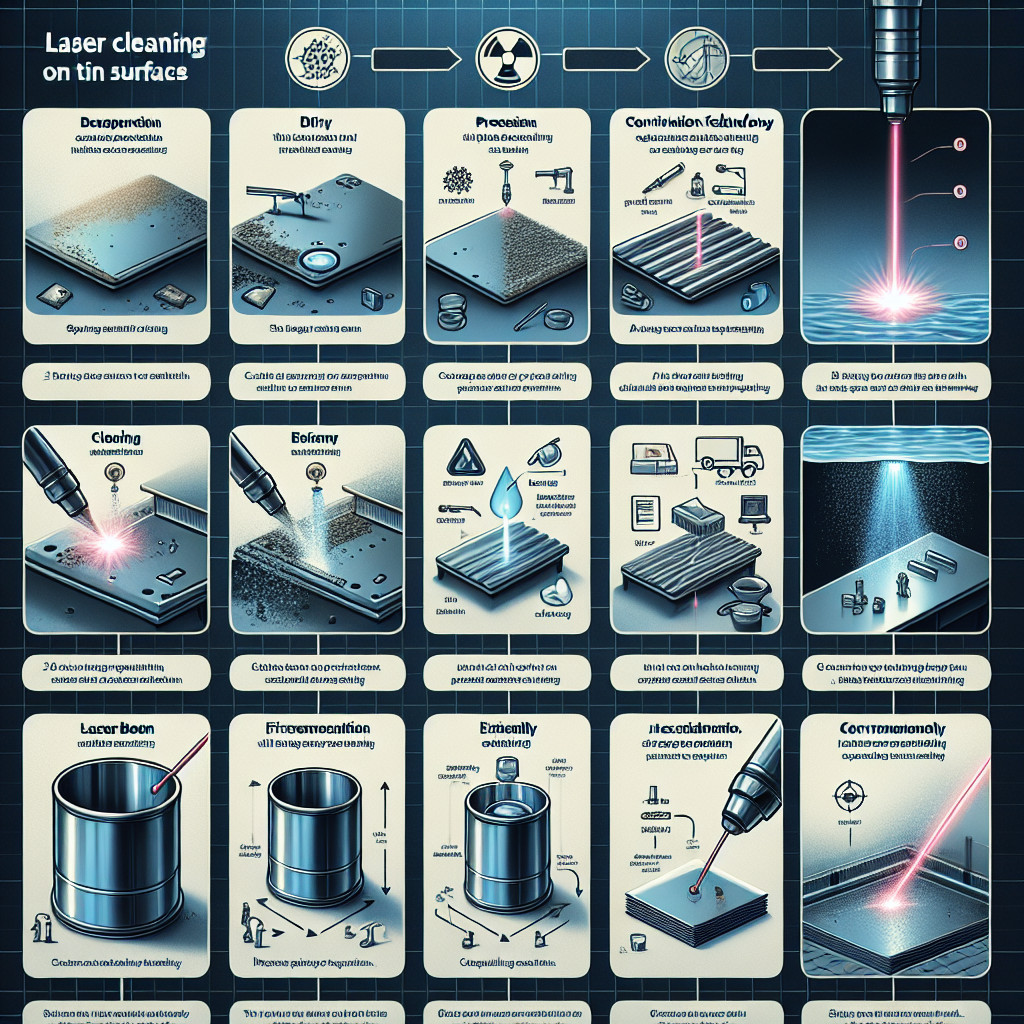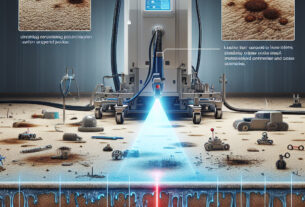- Benefits of laser cleaning for tin surfaces
- Comparison of laser cleaning vs traditional cleaning methods for tin surfaces
- Effectiveness of laser cleaning in removing contaminants from tin surfaces
- Applications of laser cleaning in tin surface preparation
- Cost analysis of laser cleaning for tin surface maintenance
Benefits of laser cleaning for tin surfaces
Efficiency
Laser cleaning is a highly efficient process that can remove contaminants from tin surfaces quickly and effectively. The laser beam is directed at the surface, where it vaporizes the contaminants, leaving behind a clean surface. This process is much faster than traditional cleaning methods, such as chemical cleaning or abrasive blasting, which can be time-consuming and labor-intensive.
Precision
Laser cleaning is a precise process that allows for targeted cleaning of specific areas on a tin surface. This level of precision is especially important for delicate tin surfaces that may be easily damaged by traditional cleaning methods. With laser cleaning, only the contaminants are removed, leaving the underlying material intact.
Environmentally friendly
Laser cleaning is an environmentally friendly cleaning method that does not require the use of harsh chemicals or abrasive materials. This makes it a safer and more sustainable option for cleaning tin surfaces. Additionally, laser cleaning produces minimal waste, as the contaminants are vaporized and can be easily collected and disposed of properly.
Cost-effective
While laser cleaning technology may have a higher upfront cost compared to traditional cleaning methods, it can ultimately save money in the long run. Laser cleaning is a fast and efficient process that requires less labor and fewer resources than traditional cleaning methods. This can result in cost savings for businesses that use laser cleaning for tin surfaces.
Versatility
Laser cleaning is a versatile technology that can be used on a wide range of tin surfaces, regardless of their size or shape. This makes it an ideal cleaning method for tin components in various industries, such as electronics, automotive, and aerospace. Whether cleaning tin plates, tin cans, or tin components, laser cleaning can effectively remove contaminants and restore the surface to its original condition.
Conclusion
In conclusion, laser cleaning offers numerous benefits for cleaning tin surfaces. From efficiency and precision to environmental friendliness and cost-effectiveness, laser cleaning is a superior cleaning method for maintaining tin surfaces. Businesses that use laser cleaning technology can enjoy clean, pristine tin surfaces without the need for harsh chemicals or abrasive materials. Overall, laser cleaning is a cutting-edge technology that is revolutionizing the way tin surfaces are cleaned and maintained.
Comparison of laser cleaning vs traditional cleaning methods for tin surfaces
Laser Cleaning
Laser cleaning is a non-contact method that uses a high-energy laser beam to remove contaminants from the surface of a material. The laser beam is focused on the surface, causing the contaminants to vaporize and be removed without damaging the underlying material. Laser cleaning is highly precise and can be used to clean even the most delicate surfaces without causing any damage.
One of the main advantages of laser cleaning is its efficiency. It can remove contaminants quickly and effectively, saving time and labor costs. Laser cleaning is also environmentally friendly, as it does not require the use of chemicals or solvents. Additionally, laser cleaning is a dry process, so there is no need for drying time after cleaning.
Traditional Cleaning Methods
Traditional cleaning methods for tin surfaces include chemical cleaning, mechanical cleaning, and abrasive cleaning. Chemical cleaning involves the use of solvents or detergents to remove contaminants from the surface. Mechanical cleaning uses brushes or scrubbing pads to physically remove contaminants. Abrasive cleaning involves the use of abrasive materials, such as sandpaper or steel wool, to scrub away contaminants.
While traditional cleaning methods can be effective, they have some drawbacks. Chemical cleaning can be harmful to the environment and may leave behind residue on the surface. Mechanical cleaning can be labor-intensive and may cause damage to the surface if not done carefully. Abrasive cleaning can also damage the surface and may leave scratches or marks.
Comparison
When comparing laser cleaning to traditional cleaning methods for tin surfaces, several factors should be considered. Laser cleaning is more efficient and precise than traditional methods, making it ideal for cleaning delicate surfaces. It is also environmentally friendly and does not require the use of chemicals or solvents.
Traditional cleaning methods, on the other hand, may be more cost-effective for large-scale cleaning operations. They are also more versatile and can be used on a wider range of surfaces. However, traditional methods may be more time-consuming and labor-intensive than laser cleaning.
Conclusion
In conclusion, laser cleaning is a highly effective and efficient method for cleaning tin surfaces. It offers many advantages over traditional cleaning methods, including precision, speed, and environmental friendliness. While traditional methods may still have their place in certain situations, laser cleaning is the superior choice for most cleaning applications.
Effectiveness of laser cleaning in removing contaminants from tin surfaces
Laser cleaning works by using a high-powered laser beam to vaporize contaminants on the surface of the material. The laser beam is directed at the contaminated area, causing the contaminants to heat up and evaporate, leaving behind a clean surface. This process is highly effective at removing even the most stubborn contaminants from tin surfaces, without causing any damage to the underlying material.
There are several advantages to using laser cleaning for removing contaminants from tin surfaces:
- Efficiency: Laser cleaning is a fast and efficient process that can remove contaminants from tin surfaces in a matter of seconds. This makes it ideal for high-volume production environments where time is of the essence.
- Precision: Laser cleaning is a highly precise process that can target specific areas on a tin surface without affecting the surrounding material. This allows for greater control over the cleaning process and ensures that only the contaminants are removed.
- Environmentally friendly: Laser cleaning does not require the use of harsh chemicals or solvents, making it an environmentally friendly cleaning solution. This is especially important in industries where strict environmental regulations are in place.
- Cost-effective: While the initial cost of purchasing a laser cleaning system may be high, the long-term cost savings can be significant. Laser cleaning requires minimal maintenance and consumables, making it a cost-effective cleaning solution in the long run.
Overall, laser cleaning has proven to be a highly effective method for removing contaminants from tin surfaces. Its efficiency, precision, environmental friendliness, and cost-effectiveness make it an attractive option for industries looking to improve the quality of their products and reduce cleaning time and costs.
Applications of laser cleaning in tin surface preparation
Laser cleaning is a cutting-edge technology that has revolutionized the way surfaces are prepared in various industries. One of the key applications of laser cleaning is in tin surface preparation. Tin is a versatile metal that is used in a wide range of applications, from electronics to food packaging. However, before tin can be used in these applications, its surface must be properly prepared to ensure optimal performance. Laser cleaning offers a fast, efficient, and environmentally friendly way to prepare tin surfaces for use.
Benefits of laser cleaning in tin surface preparation:
1. Efficiency: Laser cleaning is a highly efficient process that can remove contaminants, oxides, and other impurities from tin surfaces quickly and effectively. This allows for faster production times and increased productivity.
2. Precision: Laser cleaning is a precise process that can be controlled with great accuracy. This ensures that only the targeted contaminants are removed, leaving the underlying tin surface intact.
3. Environmentally friendly: Laser cleaning is a non-contact process that does not require the use of chemicals or abrasive materials. This makes it an environmentally friendly alternative to traditional surface preparation methods.
4. Cost-effective: While the initial investment in laser cleaning equipment may be higher than traditional cleaning methods, the long-term cost savings can be significant. Laser cleaning requires less maintenance and consumables, resulting in lower operating costs over time.
5. Versatility: Laser cleaning can be used on a wide range of tin surfaces, including flat sheets, coils, and components. This versatility makes it a valuable tool for tin manufacturers and fabricators.
6. Safety: Laser cleaning is a safe process that eliminates the need for manual cleaning methods that can expose workers to hazardous chemicals and fumes. This helps to create a safer work environment for employees.
7. Quality: Laser cleaning produces a clean, uniform surface finish that is free from scratches, burrs, and other defects. This ensures that the tin surfaces meet the highest quality standards.
How laser cleaning works:
Laser cleaning works by using a high-powered laser beam to vaporize contaminants and impurities on the surface of the tin. The laser beam is directed at the surface, where it heats and vaporizes the contaminants, leaving behind a clean tin surface. The process is highly controlled and can be adjusted to remove different types of contaminants without damaging the underlying tin.
Conclusion:
In conclusion, laser cleaning is a valuable tool for tin surface preparation in a wide range of industries. Its efficiency, precision, and environmental friendliness make it an attractive alternative to traditional cleaning methods. By investing in laser cleaning technology, tin manufacturers and fabricators can improve their production processes, reduce costs, and ensure the highest quality tin surfaces for their products.
Cost analysis of laser cleaning for tin surface maintenance
Benefits of laser cleaning for tin surfaces
Laser cleaning offers several advantages over traditional cleaning methods such as chemical cleaning or abrasive blasting. Some of the key benefits of laser cleaning for tin surfaces include:
- Non-contact cleaning process
- No use of chemicals or abrasive materials
- Precision cleaning with minimal material loss
- Environmentally friendly
- Reduced downtime for maintenance
These benefits make laser cleaning an attractive option for maintaining tin surfaces in various industries, including electronics, automotive, and aerospace.
Cost analysis of laser cleaning
When considering the cost of laser cleaning for tin surface maintenance, it is important to take into account several factors:
- Initial investment in laser cleaning equipment
- Operating costs, including electricity and maintenance
- Cost savings from reduced downtime and material loss
- Long-term cost benefits of using laser cleaning over traditional methods
While the initial investment in laser cleaning equipment may be higher than traditional cleaning methods, the long-term cost benefits often outweigh the upfront costs. Laser cleaning is a more efficient and precise method of cleaning tin surfaces, leading to reduced downtime and material loss.
Case study: Cost comparison of laser cleaning vs. chemical cleaning
Let’s consider a hypothetical case study comparing the cost of laser cleaning versus chemical cleaning for maintaining tin surfaces in a manufacturing plant. The plant currently uses chemical cleaning methods, which require the purchase of cleaning chemicals and disposal of hazardous waste.
By switching to laser cleaning, the plant can eliminate the need for chemicals and reduce the amount of hazardous waste generated. While the initial investment in laser cleaning equipment may be higher, the long-term cost savings from reduced downtime and material loss can offset the upfront costs.
Furthermore, laser cleaning offers a more precise and environmentally friendly cleaning solution, which can lead to improved product quality and customer satisfaction.
Conclusion
In conclusion, the cost analysis of laser cleaning for tin surface maintenance shows that this technology offers a cost-effective and efficient solution for maintaining surfaces in various industries. While the initial investment in laser cleaning equipment may be higher than traditional methods, the long-term cost benefits make it a worthwhile investment.
By considering the benefits of laser cleaning, including reduced downtime, material loss, and environmental impact, businesses can make informed decisions about incorporating this technology into their maintenance processes.
- Sure! Here are some questions related to Software for tracking employee hours: - 7 November 2025
- The role of AI in Employee monitoring software - 6 November 2025
- Sure! Here are some questions related to The role of computer monitoring software in education, using variations of the term computer monitoring software: - 3 October 2025



